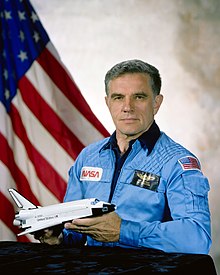Karl Henize | |
|---|---|
 | |
| Born | Karl Gordon Henize October 17, 1926 Cincinnati, Ohio, U.S. |
| Died | October 5, 1993 (aged 66) |
| Education | University of Virginia (BA, MA) University of Michigan (PhD) |
| Space career | |
| NASA astronaut | |
| Rank | Lieutenant Commander, USNR |
Time in space | 7d 22h 45min |
| Selection | NASA Group 6 (1967) |
| Missions | STS-51-F |
Mission insignia | |
| Retirement | April 1986 |
| Scientific career | |
| Fields | Astronomy |
| Thesis | The Michigan-Mount Wilson Survey of the Southern Sky for Hα-Emission Stars and Nebulae (1954) |
Karl Gordon Henize (/ˈhɛnaɪz/;[1] October 17, 1926 – October 5, 1993) was an American astronomer, space scientist, NASA astronaut, and professor at Northwestern University. He was stationed at several observatories around the world, including McCormick Observatory, Lamont–Hussey Observatory (South Africa), Mount Wilson Observatory, Smithsonian Astrophysical Observatory and Mount Stromlo Observatory (Australia). He was a member of the astronaut support crew for Apollo 15 and Skylab 2, 3, and 4. As a mission specialist on the Spacelab-2 mission (STS-51-F), he flew on Space Shuttle Challenger in July/August 1985. He was awarded the NASA Exceptional Scientific Achievement Medal in 1974.
He died in 1993, during a Mount Everest expedition while testing equipment for NASA.
- ^ JPL-80 "NASA Creates Portrait of Life and Death in the Universe" Archived September 21, 2008, at the Wayback Machine, 2004 News Releases, NASA Jet Propulsion Laboratory, Pasadena, California (US), March 8, 2004